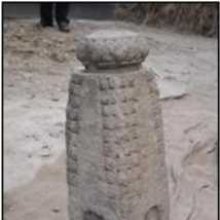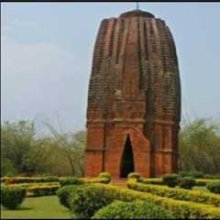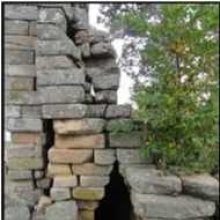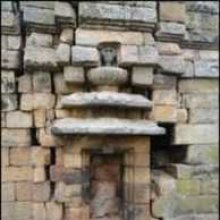Deula, Dēūḷa, Deūla: 4 definitions
Introduction:
Deula means something in Hinduism, Sanskrit, Marathi, Jainism, Prakrit. If you want to know the exact meaning, history, etymology or English translation of this term then check out the descriptions on this page. Add your comment or reference to a book if you want to contribute to this summary article.
The Sanskrit term Dēūḷa can be transliterated into English as Deula or Deulia, using the IAST transliteration scheme (?).
Images (photo gallery)
Languages of India and abroad
Marathi-English dictionary
Source: DDSA: The Molesworth Marathi and English Dictionarydēūḷa (देऊळ).—n (dēvālaya S) An idol-house; a temple.
Source: DDSA: The Aryabhusan school dictionary, Marathi-Englishdēūḷa (देऊळ).—n An idol-house; a temple.
Marathi is an Indo-European language having over 70 million native speakers people in (predominantly) Maharashtra India. Marathi, like many other Indo-Aryan languages, evolved from early forms of Prakrit, which itself is a subset of Sanskrit, one of the most ancient languages of the world.
Sanskrit dictionary
[Sanskrit to German]
Sanskrit, also spelled संस्कृतम् (saṃskṛtam), is an ancient language of India commonly seen as the grandmother of the Indo-European language family (even English!). Closely allied with Prakrit and Pali, Sanskrit is more exhaustive in both grammar and terms and has the most extensive collection of literature in the world, greatly surpassing its sister-languages Greek and Latin.
Prakrit-English dictionary
Source: DDSA: Paia-sadda-mahannavo; a comprehensive Prakrit Hindi dictionaryDeula (देउल) in the Prakrit language is related to the Sanskrit word: Devakula.
Prakrit is an ancient language closely associated with both Pali and Sanskrit. Jain literature is often composed in this language or sub-dialects, such as the Agamas and their commentaries which are written in Ardhamagadhi and Maharashtri Prakrit. The earliest extant texts can be dated to as early as the 4th century BCE although core portions might be older.
See also (Relevant definitions)
Starts with: Deulaghanta, Deularaula, Deulavada.
Query error!
Full-text: Jhadapidya, Devakula, Mahinevala, Bhangasala, Raula, Ghadi, Jevanem, Angaca.
Relevant text
Search found 9 books and stories containing Deula, Dēūḷa, Deūla, Dēula; (plurals include: Deulas, Dēūḷas, Deūlas, Dēulas). You can also click to the full overview containing English textual excerpts. Below are direct links for the most relevant articles:
Temples of Purushottama Kshetra Puri (by Ratnakar Mohapatra)
3.1. Rekha Temple or Deula < [Chapter 2 - Characteristics features of Orissan Temples]
3.2. Pidha Deula type of Temple < [Chapter 2 - Characteristics features of Orissan Temples]
3.3. Khakhara Deula type of Temple < [Chapter 2 - Characteristics features of Orissan Temples]
Chaitanya Bhagavata (by Bhumipati Dāsa)
Verse 3.4.67 < [Chapter 4 - Descriptions of Śrī Acyutānanda’s Pastimes and the Worship of Śrī Mādhavendra]
Verse 1.17.33 < [Chapter 17 - The Lord’s Travel to Gayā]
Who’s Who Among our Contributors < [April – June, 2001]
Jain Remains of Ancient Bengal (by Shubha Majumder)
Archaeological sites in West Midnapur District < [Chapter 4 - Distribution of Sites Yielding Jaina Remains]
Ancient Habitational Complexes or Beneath the Trees < [Chapter 5 - Jaina Architectural and Sculptural Remains]
Abandoned Temples/Structural Ruins Containing Sculptural Specimens < [Chapter 5 - Jaina Architectural and Sculptural Remains]
Shaivacintamani (analytical study) (by Swati Sucharita Pattanaik)
Part 1.3 - Lord Liṅgarāja or Tribhubaneswar or Kṛttivāsa < [Chapter 2: Śaivism in Śaiva Purāṇas of Odisha]
Part 2 - The Origin and Development of Śaivism in Orissa (Odisha) < [Chapter 1: Introduction to Śaivism]
Paumacariya (critical study) (by K. R. Chandra)
4.4. Other constructions for shelter, etc. < [Chapter 8 - Education, Literature, Sciences, Arts and Architecture]



